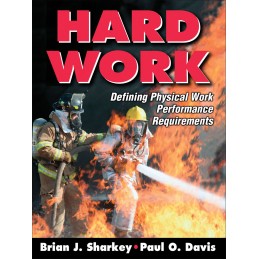- Obniżka


 Dostawa
Dostawa
Wybierz Paczkomat Inpost, Orlen Paczkę, DHL, DPD, Pocztę, email (dla ebooków). Kliknij po więcej
 Płatność
Płatność
Zapłać szybkim przelewem, kartą płatniczą lub za pobraniem. Kliknij po więcej szczegółów
 Zwroty
Zwroty
Jeżeli jesteś konsumentem możesz zwrócić towar w ciągu 14 dni*. Kliknij po więcej szczegółów
Hard Work:: Defining Physical Work Performance Requirements focuses on physically demanding occupations that require strength and stamina, such as law enforcement, structural and wildland firefighting, mining, forestry, and the military. It is the first book to examine the relationship of recruitment practices, physical training, and physical evaluation to the intricate environment of corporations, labor organizations, the legal system, and employment rights.
Hard Work assists readers in making intelligent and informed decisions resulting in a safer, healthier, and more productive work force. Authors Brian Sharkey and Paul Davis have spent more than 70 years combined researching worker performance in physically demanding professions. Hard Work brings their perspective as exercise scientists to an examination of these factors::
-Work requirements and capacity for physically demanding jobs
-Physical characteristics of the “athlete-worker,” including aerobic and muscular fitness
-Test development, validation, and utilization in employee selection
-Employee health and job-related fitness
-Environmental factors affecting employee performance, such as heat, cold, and altitude
-Respiratory protection and lifting guidelines
-Legal aspects of employment, consequences of legal decisions, and a proposed alternative to litigation
By using case studies and real-life examples of tests and programs, the authors teach readers how to evaluate recruits and maintain employee health and safety. The book also includes nine appendixes offering valuable perspectives on testing, job-related fitness, policies, procedures, and performance assessment.
Hard Work:: Defining Physical Work Performance Requirements is organized into five parts. Part I begins with definitions of the physically demanding occupation and characteristics of workers available for employment. The legal aspects of employment are also considered, including reference to age, gender, race, and disability.
Part II examines the value of initial and periodic evaluations, the test development process, and issues related to testing. Additionally, part II contains an examination of the effects of court decisions and labor unions on the evaluation processes of both new and incumbent employees.
Part III discusses implementation of recruit testing designed to determine those individuals who can and cannot perform the job. The inherent challenges in shifting from recruit testing to periodic tests for incumbents are described, and ways to evaluate the costs and benefits of testing and training programs are examined.
In part IV, the values and limits of medical examinations and employee wellness programs are considered. Part IV also discusses work physiology and its relationship to performance and presents the job-related physical fitness program as the essential element required for preserving career-long performance and health.
Part V discusses employee performance in extreme environments, respiratory protection devices and their impact on the worker, and guidelines designed to reduce the risk of back injuries. It concludes with an examination of legal issues and a proposed alternative to litigation using a collective approach that avoids confrontation and biased testimony and saves taxpayer money.
Hard Work:: Defining Physical Work Performance Requirements suggests how workers could benefit by working up to job requirements while maintaining their health, safety, and job performance. This unique text seeks to bring about a paradigm shift wherein workers are viewed as occupational athletes who, aided by effective recruitment, testing, and training, receive the necessary support to help them excel in their physically demanding workplace.
Opis
Part I: The Job and the Worker
Chapter 1: Physically Demanding Occupations
Hard Work
Work Requirements
Work Capacity
Summary
Chapter 2: The Worker
Physical Characteristics of Workers
Aerobic Fitness
Muscular Fitness
Demographic Trends
Summary
Chapter 3: Employment Opportunity
Employment Laws
Uniform Guidelines on Employee Selection Procedures
Summary
Part II: Test Development and Validation
Chapter 4: Job-Related Tests
Why Test?
Testing and Legal Issues
Test Development
Summary
Chapter 5: Test Validation
Content Validity
Criterion-Related Validity
Construct Validity
Validation Options
Reliability and Cross-Validation
Bona Fide Occupational Qualification
Absolute Standards
Test Standards
Suboptimal Selection Procedures
Summary
Chapter 6: Test Implementation
Seeking Professional Assistance
Personnel Issues
Implementation Strategies
Summary
Part III: Employee Selection Practices
Chapter 7: Testing New Employees
Medical Standards
Safety Considerations
Instructions
Recruitment
Pretest Training
Retesting
Work Hardening
Summary
Chapter 8: Testing Incumbent Employees
Age and Performance
Physiological Age
Periodic Testing
Providing Adequate Notice
Medical and Safety
Fitness Training
Test Results
Summary
Chapter 9: Program Evaluation
Evaluation
Surveillance System
Analysis: Quantitative and Qualitative Information
Cost-Benefit Analysis
Reporting Results
Summary
Part IV: Employee Health, Physiology, and Performance
Chapter 10: Employee Health
Developing Medical Standards
Employee Health Programs
Costs and Benefits of Employee Health Programs
Summary
Chapter 11: Physiology of Work
Muscle Fibers
Muscle Contractions
Energy Sources
Oxygen and Energy
Supply and Support Systems
The Training Effect
Summary
Chapter 12: Job-Related Fitness
The Job-Related Fitness Programs
Aerobic Fitness
Muscular Fitness
Core Training
Periodizing the Training Plan
Body Composition
Program Issues
Risks and Benefits
Summary
Part V: Job-Related Issues
Chapter 13: Environmental Impacts
Heat Stress and Heat Disorders
Preventing Heat Disorders
Cold Conditions
Altitude Acclimatization
Summary
Chapter 14: Respiratory Protection
Respiratory Hazards
Respirator Selection
Medical Evaluation
Work Performance
APRs and Women
Summary
Chapter 15: Lifting Guidelines
Lifting Standards
NIOSH Lifting Equation
Selection and Training
Summary
Chapter 16: Legal Issues
Legal Challenges
Unintended Consequences
Court Decisions
Alternative to Litigation
Summary
Indeks: 57100
Autor:
Indeks: 36938
Autor: Stephen Ruoss
